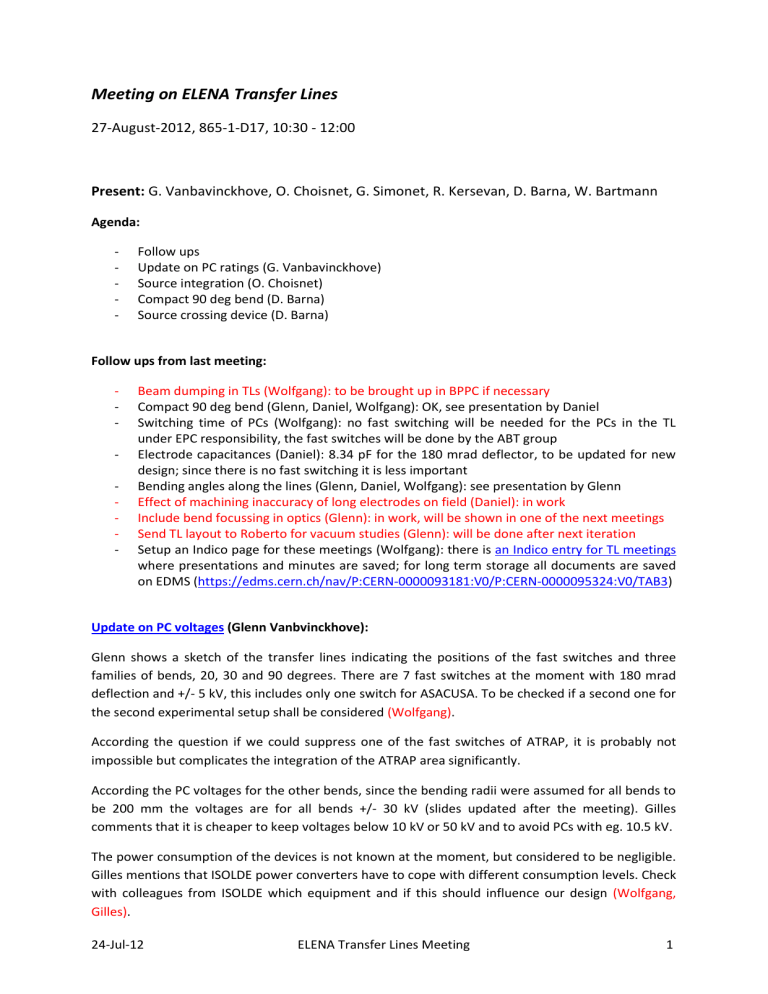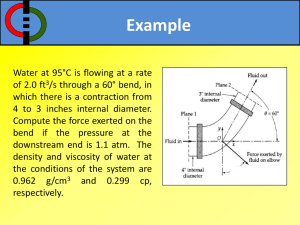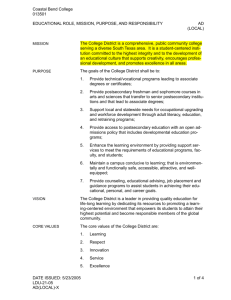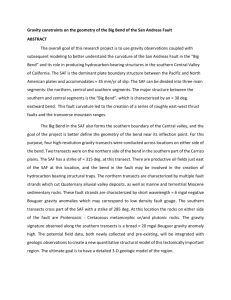min_TLWG_27Aug12 - Indico

Meeting on ELENA Transfer Lines
27-August-2012, 865-1-D17, 10:30 - 12:00
Present: G. Vanbavinckhove, O. Choisnet, G. Simonet, R. Kersevan, D. Barna, W. Bartmann
Agenda:
Follow ups
Update on PC ratings (G. Vanbavinckhove)
Source integration (O. Choisnet)
Compact 90 deg bend (D. Barna)
Source crossing device (D. Barna)
Follow ups from last meeting:
Beam dumping in TLs (Wolfgang): to be brought up in BPPC if necessary
Compact 90 deg bend (Glenn, Daniel, Wolfgang): OK, see presentation by Daniel
Switching time of PCs (Wolfgang): no fast switching will be needed for the PCs in the TL under EPC responsibility, the fast switches will be done by the ABT group
Electrode capacitances (Daniel): 8.34 pF for the 180 mrad deflector, to be updated for new design; since there is no fast switching it is less important
Bending angles along the lines (Glenn, Daniel, Wolfgang): see presentation by Glenn
Effect of machining inaccuracy of long electrodes on field (Daniel): in work
Include bend focussing in optics (Glenn): in work, will be shown in one of the next meetings
Send TL layout to Roberto for vacuum studies (Glenn): will be done after next iteration
Setup an Indico page for these meetings (Wolfgang): there is an Indico entry for TL meetings where presentations and minutes are saved; for long term storage all documents are saved on EDMS ( https://edms.cern.ch/nav/P:CERN-0000093181:V0/P:CERN-0000095324:V0/TAB3 )
Update on PC voltages (Glenn Vanbvinckhove):
Glenn shows a sketch of the transfer lines indicating the positions of the fast switches and three families of bends, 20, 30 and 90 degrees. There are 7 fast switches at the moment with 180 mrad deflection and +/- 5 kV, this includes only one switch for ASACUSA. To be checked if a second one for the second experimental setup shall be considered (Wolfgang) .
According the question if we could suppress one of the fast switches of ATRAP, it is probably not impossible but complicates the integration of the ATRAP area significantly.
According the PC voltages for the other bends, since the bending radii were assumed for all bends to be 200 mm the voltages are for all bends +/- 30 kV (slides updated after the meeting). Gilles comments that it is cheaper to keep voltages below 10 kV or 50 kV and to avoid PCs with eg. 10.5 kV.
The power consumption of the devices is not known at the moment, but considered to be negligible.
Gilles mentions that ISOLDE power converters have to cope with different consumption levels. Check with colleagues from ISOLDE which equipment and if this should influence our design (Wolfgang,
Gilles) .
24-Jul-12 ELENA Transfer Lines Meeting 1
Compact 90 deg bend (Daniel Barna):
As a follow up from last meeting Daniel looked into the feasibility of a compact 90 deg bend as required for the vertical bends at ATRAP and possibly for a future experiment close to GBAR.
Dispersion optimisation leads to a 200 mm bending radius device which requires voltages of +/- 30 kV. There is about 30-40% less dispersion than for the 500 mm bending radius bend. Daniel shows the effect of distributing differently the voltage on the inner and outer electrodes. Depending on the voltage distribution particles follow a different path in the electrostatic field and therefore they lose or gain energy. This results in a difference in the focussing effect of the bend, while the focussing in the plane of bending stays rather constant it changes signifcantly in the other plane.
The compact 90 deg bend with radius 200 mm is feasible and its voltage distribution can be tuned for the optimum focussing effect.
Source integration (Olivier Choisnet):
Olivier shows two options of source positions. In the first variant the source is located below the extraction line which is preferable from integration point of view. This location is chosen to allow for passage, which explains the kink in the line right after the source.
The second variant assumes the source to be symmetrically placed between injection and extraction line, with a distance between source and crossing device of about 1 m.
Source crossing device (Daniel Barna):
There is a clear priority of the antiproton transfer with respect to the beam transfer from the source for commissioning reasons. Daniel shows two possible solutions for the integration variant with the source below the extraction line. There is a very strong bend needed for the H- while the ejected antiprotons need to be bent too. This all-in-one device is very difficult to design with reasonable field homogenity for the high-priority antiproton beam. The second layout shows a solution with seperated kicker and bending functionalty which should improve the respective field qualities. The H- beam would be bent by a parallel plate 15 deg bend which has to provide the same kick for the antiprotons going in the other direction, then a curved ~60 deg bend and a again a parallel plate 15 deg bend to inject into the AD-to-ELENA TL. There are still extra bends needed for the antiproton extraction line which creates extrac dispersion and reduces the beam acceptance of the line downstream. Simulation of the 15 deg parallel plate kicker shows that the beam is getting close to the electrode which requires changing the electrode geometry for large bending angles.
Having the ion source in the middle of extraction and injection line allows the antiprotons to have a straight path and also smaller bending angles for the ions coming from the source. Using the seperated kicker and bend approach as for the other option results in a large roundabout chamber of about 1 m in diameter. The prize could be up to 35 kCH for such a device. The space without being able to place quadrupoles is about 1.5 m. According stability of this device stiffeners inside the chamber could be envisaged.
A more compact layout with two 23 deg bends could fit in a normal vacuum chamber, the electric field homogeneity is poor but not affecting the antiproton beam. Daniel shows two 23 deg angle
24-Jul-12 ELENA Transfer Lines Meeting 2
electrode designs, one bending in both directions and one accepting a straight and a bent beam. A voltage of ~ +/- 15 kV is required.
The preferred layout assumes the ion source in the middle between injection and ejection line. In case there is not enough space it is preferred to locate the source parallel to the ejection line and introduce an extra bend for the H- ions to keep the symmetry of the crossing device. The integration of this option remains to be checked (Olivier) .
Next meeting: 3
rd September, iterating on the source lines.
24-Jul-12 ELENA Transfer Lines Meeting 3








